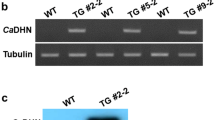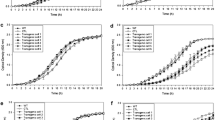Abstract
We investigated Arctic plants to determine if they have a specific mechanism enabling them to adapt to extreme environments because they are subject to such conditions throughout their life cycles. Among the cell defense systems of the Arctic mouse-ear chickweed Cerastium arcticum, we identified a stress-responsive dehydrin gene CaDHN that belongs to the SK5 subclass and contains conserved regions with one S segment at the N-terminus and five K segments from the N-terminus to the C-terminus. To investigate the molecular properties of CaDHN, the yeast Saccharomyces was transformed with CaDHN. CaDHN-expressing transgenic yeast (TG) cells recovered more rapidly from challenge with exogenous stimuli, including oxidants (hydrogen peroxide, menadione, and tert-butyl hydroperoxide), high salinity, freezing and thawing, and metal (Zn2+), than wild-type (WT) cells. TG cells were sensitive to copper, cobalt, and sodium dodecyl sulfate. In addition, the cell survival of TG cells was higher than that of WT cells when cells at the mid-log and stationary stages were exposed to increased ethanol concentrations. There was a significant difference in cultures that have an ethanol content >16 %. During glucose-based batch fermentation at generally used (30 °C) and low (18 °C) temperatures, TG cells produced a higher alcohol concentration through improved cell survival. Specifically, the final alcohol concentrations were 13.3 and 13.2 % in TG cells during fermentation at 30 and 18 °C, respectively, whereas they were 10.2 and 9.4 %, respectively, in WT cells under the same fermentation conditions. An in vitro assay revealed that purified CaDHN acted as a reactive oxygen species scavenger by neutralizing H2O2 and a chaperone by preventing high temperature-mediated catalase inactivation. Taken together, our results show that CaDHN expression in transgenic yeast confers tolerance to various abiotic stresses by improving redox homeostasis and enhances fermentation capacity, especially at low temperatures (18 °C).




Similar content being viewed by others
References
Allagulova CR, Gimalov FR, Shakirova FM, Vakhitov VA (2003) The plant dehydrins: structure and putative functions. Biochemistry (Mosc) 68:945–951
Alsheikh MK, Heyen BJ, Randall SK (2003) Ion binding properties of the dehydrin ERD14 are dependent upon phosphorylation. J Biol Chem 278:40882–40889
Archambault A, Strömvik MV (2011) PR-10, defensin and cold dehydrin genes are among those over expressed in Oxytropis (Fabaceae) species adapted to the arctic. Funct Integr Genomics 11:497–505
Battaglia M, Olvera-Carrillo Y, Garciarrubio A, Campos F, Covarrubias AA (2008) The enigmatic LEA proteins and other hydrophilins. Plant Physiol 148:6–24
Belloch C, Orlic S, Barrio E, Querol A (2008) Fermentative stress adaptation of hybrids within the Saccharomyces sensu stricto complex. Int J Food Microbiol 122:188–195
Bokhorst S, Bjerke JW, Davey MP, Taulavuori K, Taulavuori E, Laine K, Callaqhan TV, Phoenix GK (2010) Impacts of extreme winter warming events on plant physiology in a sub-Arctic heath community. Physiol Plant 140:128–140
Brini F, Hanin M, Lumbreras V, Lumbreras V, Amara I, Khoudi H, Hassaira A, Pagès M, Masamoudi K (2007) Overexpression of wheat dehydrin DHN-5 enhances tolerance to salt and osmotic stress in Arabidopsis thaliana. Plant Cell Rep 26:2017–2026
Campos F, Zamudio F, Covarrubias AA (2006) Two different late embryogenesis abundant proteins from Arabidopsis thaliana contain specific domains that inhibit Escherichia coli growth. Biochem Biophys Res Commun 342:406–413
Cebollero E, Gonzalez-Ramos D, Tabera L, Gonzalez R (2007) Transgenic wine yeast technology comes of age: is it time for transgenic wine? Biotechnol Lett 29:191–200
Chew O, Lelean S, John UP, Spangenberg GC (2012) Cold acclimation induces rapid and dynamic changes in freeze tolerance mechanisms in the cryophile Deschampsia antarctica E. Desv. Plant Cell Environ 35:829–837
Ding J, Huang X, Zhang L, Zhao N, Yang D, Zhang K (2009) Tolerance and stress response to ethanol in the yeast Saccharomyces cerevisiae. Appl Microbiol Biotechnol 85:253–263
Gibson BR, Lawrence SJ, Leclaire JP, Powell CD, Smart KA (2007) Yeast responses to stresses associated with industrial brewery handling. FEMS Microbiol Rev 31:535–569
Gidekel M, Destefano-Beltrán L, García P, Mujica L, Leal P, Cuba M, Fuentes L, Bravo LA, Corcuera LJ, Alberdi M, Concha I, Gutiérrez A (2003) Identification and characterization of three novel cold acclimation-responsive genes from the extremophile hair grass Deschampsia antarctica Desv. Extremophiles 7:459–469
Gietz RD, Woods RA (2001) Genetic transformation of yeast. Biotechniques 30:816–820
Gomes DG, Guimarães PM, Pereira FB, Teixeira JA, Domingues L (2012) Plasmid-mediate transfer of FLO1 into indusrial Saccharomyces cerevisiae PE-2 strain creates a strain useful for repeat-batch fermentations involving flocculation-sedimentation. Bioresour Technol 108:162–168
Hagen AR, Giese H, Brochmann C (2001) Trans-Atlantic dispersal and phylogeography of Cerastium arcticum (Caryophyllaceae) inferred from RAPD and SCAR markers. Am J Bot 88:103–112
Hanin M, Brini F, Ebel C, Toda Y, Takeda S, Masmoudi K (2011) Plant dehydrins and stress tolerance: versatile proteins for complex mechanisms. Plant Signal Behav 6:1503–1509
Hara M, Terashima S, Fukaya T, Kuboi T (2003) Enhancement of cold tolerance and inhibition of lipid peroxidation by citrus dehydrin in transgenic tobacco. Planta 217:290–298
Hara M, Fujinaga M, Kuboi T (2005) Metal binding by citrus dehydrin with histidine-rich domains. J Exp Bot 56:2695–2703
Heyen BJ, Alsheikh MK, Smith EA, Torvik CF, Seals DF, Randall SK (2002) The calcium-binding activity of a vacuole-associated, dehydrin-like protein is regulated by phosphorylation. Plant Physiol 130:675–687
Kim IS, Jin I, Yoon HS (2011) Decarbonylated cyclophilin A Cpr1 protein protects Saccharomyces cerevisiae KNU5377Y when exposed to stress induced by menadione. Cell Stress Chaperones 16:1–14
Kim IS, Kim YS, Yoon HS (2012) Rice ASR1 protein with reactive oxygen species scavenging and chaperone-like activities enhances acquired tolerance to abiotic stresses in Saccharomyces cerevisiae. Mol Cells 33:285–293
Kovacs D, Kalmar E, Torok Z, Tompa P (2008) Chaperone activity of ERD10 and ERD14, two disordered stress-related plant proteins. Plant Physiol 147:381–390
Krüger C, Berkowitz O, Stephan UW, Hell R (2002) A metal-binding member of the late embryogenesis abundant protein family transports iron in the phloem of Ricinus communis L. J Biol Chem 277:25062–25069
Lång V, Palva ET (1992) The expression of a rab-related gene, rab18, is induced by abscisic acid during the cold acclimation process of Arabidopsis thaliana (L.) Heynh. Plant Mol Biol 20:951–962
Ma M, Liu ZL (2010) Mechanisms of ethanol tolerance in Saccharomyces cerevisiae. Appl Microbiol Biotechnol 87:829–845
Mouillon JM, Eriksson SK, Harryson P (2008) Mimicking the plant cell interior under water stress by macromolecular crowding: disordered dehydrin proteins are highly resistant to structural collapse. Plant Physiol 148:1925–1937
Mumberg D, Müller R, Funk M (1995) Yeast vectors for the controlled expression of heterologous proteins in different genetic backgrounds. Gene 156:119–122
Orozco H, Matallana E, Aranda A (2012) Oxidative stress tolerance, adenylate cyclase, and autophagy are key players in the chronological life span of Saccharomyces cerevisiae during winemaking. Appl Environ Microbiol 78:2748–2757
Peng Y, Reyes JL, Wei H, Yang Y, Karlson D, Covarrubias AA, Krebs SL, Fessehaie A, Arora R (2008) RcDhn5, a cold acclimation-responsive dehydrin from Rhododendron catawbiense rescues enzyme activity from dehydration effects in vitro and enhances freezing tolerance in RcDhn5-overexpressing Arabidopsis plants. Physiol Plant 134:583–597
Pizarro FJ, Jewett MC, Nielsen J, Agosin E (2008) Growth temperature exerts differential physiological and transcriptional responses in laboratory and wine strains of Saccharomyces cerevisiae. Appl Environ Microbiol 74:6358–6368
Puhakainen T, Hess MW, Mäkelä P, Svensson J, Heino P, Palva ET (2004) Overexpression of multiple dehydrin genes enhances tolerance to freezing stress in Arabidopsis. Plant Mol Biol 54:743–753
Reyes JL, Campos F, Wei H, Arora R, Yang Y, Karlson DT, Covarrubias AA (2008) Functional dissection of hydrophilins during in vitro freeze protection. Plant Cell Environ 31:1781–1790
Rorat T (2006) Plant dehydrins—tissue location, structure and function. Cell Mol Biol Lett 11:536–556
Salvadó Z, Arroyo-López FN, Guillamón JM, Salazar G, Querol A, Barrio E (2011) Temperature adaptation markedly determines evolution within the genus Saccharomyces. Appl Environ Microbiol 77:2292–2302
Stanley D, Bandara A, Fraser S, Chambers PJ, Stanley GA (2010) The ethanol stress response and ethanol tolerance of Saccharomyces cerevisiae. J Appl Microbiol 109:13–24
Sun X, Lin HH (2010) Role of dehydrins in antioxidation mechanisms. Biologia 65:755–759
Xu J, Zhang YX, Wei W, Han L, Guan ZQ, Wang Z, Chai TY (2008) BjDHNs confer heavy-metal tolerance in plants. Mol Biotechnol 38:91–98
Zhai C, Lan J, Wang H, Li L, Cheng X, Liu G (2011) Rice dehydrin K-segments have in vitro antibacterial activity. Biochemistry (Mosc) 76:645–650
Zhao XQ, Bai FW (2009) Mechanisms of yeast stress tolerance and its manipulation for efficient fuel ethanol production. J Biotechnol 144:23–30
Acknowledgements
This work was supported by a grant from the Next-Generation BioGreen 21 Program (number PJ008060022013), Rural Development Administration and funded by the Global Frontier Program (2011-0031341) of the Ministry of Education, Science and Technology (MEST), Korea.
Author information
Authors and Affiliations
Corresponding author
Electronic supplementary material
Below is the link to the electronic supplementary material.
ESM 1
(PDF 411 kb)
Rights and permissions
About this article
Cite this article
Kim, IS., Kim, HY., Kim, YS. et al. Expression of dehydrin gene from Arctic Cerastium arcticum increases abiotic stress tolerance and enhances the fermentation capacity of a genetically engineered Saccharomyces cerevisiae laboratory strain. Appl Microbiol Biotechnol 97, 8997–9009 (2013). https://doi.org/10.1007/s00253-013-4729-9
Received:
Revised:
Accepted:
Published:
Issue Date:
DOI: https://doi.org/10.1007/s00253-013-4729-9




